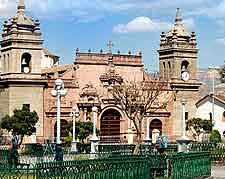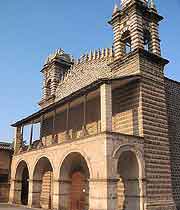Ayacucho History Facts and Timeline
(Ayacucho, Peru)

The biggest claims to fame in Ayacucho, the capital of Peru's centrally located Huamanga province, include its 30+ churches and its former status as birthplace of Peru's Shining Path armed guerrilla organisation.
Fortunately, the current chapter in the history of Ayacucho is far more peaceful and this Southern Sierra city always welcomes visitors. Today, Easter is the city's liveliest season, when literally thousands of religious pilgrims descend upon the city during its exciting Semana Santa celebrations.
Wari Empire
The earliest evidence of human habitation in the history of Ayacucho lies within the caves at the archaeological site of Pikimachay, situated some 25 km / 16 miles to the north of the present-day city. These are believed to date back in excess of 15,000 years.
A paved road to the north-east of Ayacucho leads to the stone ruins of a nearby ancient city. It was here where the Wari civilisation lived and ruled over an area covering approximately half of Peru's Andes mountains, between the years of 500 and 900 AD. Centuries later, the region became part of the mighty Inca Empire.
San Juan de la Frontera de Huamanga
When infamous Spanish invader Francisco Pizarro González conquered the area in 1540, he populated the new town of San Juan de la Frontera de Huamanga with Spanish settlers, many of whom were soldiers brought to fight against frequent Inca rebellions. The town's name was later shortened to Huamanga, a name many locals still use today, and its first university was set up as far back as 1677, clearly indicating how quickly a civilised infrastructure was established here.

Battle of Ayacucho
Many of the churches now standing within Ayacucho were built by wealthy families who profited from the city's surrounding silver mines centuries ago. Famously, this prompted writer Felipe Guamán Poma de Ayala to write a scathing series of letters during the late 17th century, against the previous Toledo viceroyalty.
The next significant event in local Peruvian history would not occur until 1824, the year that the bloody Battle of Ayacucho was fought in nearby La Quinua. Roughly 6,000 pro-independence troops from across South America successfully defeated the much larger Spanish army in this decisive battle, which not only freed Peru, but ultimately led to the independence of several other South American countries. In 1825, political leader Simon Bolivar renamed the city Ayacucho after the Quechua words for 'death' and 'corner'.
The Shining Path Organisation
Over a century and a half after the Battle of Ayacucho, the city became the birthplace of another revolutionary movement called the Shining Path. All trade was banned and countless people were murdered during the reign of this armed guerrilla organisation, founded to overthrow Peru's government during the 1970s and 1980s. This dark period in the history of Ayacucho came to an end after the 1992 arrest and imprisonment of Shining Path leader, Abimael Guzmán.
Modern Times in the City
Although cocaine production and army patrols remain a conspicuous feature of life in Ayacucho, there has rarely been a safer or more peaceful time to visit the city during its tumultuous history.
As long as tourists refrain from talking about the Shining Path years, the people of Ayacucho will welcome all visitors with open arms. This city may now be one of Peru's poorest regions, but its citizens are working hard to turn things around.
 The biggest claims to fame in Ayacucho, the capital of Peru's centrally located Huamanga province, include its 30+ churches and its former status as birthplace of Peru's Shining Path armed guerrilla organisation.
The biggest claims to fame in Ayacucho, the capital of Peru's centrally located Huamanga province, include its 30+ churches and its former status as birthplace of Peru's Shining Path armed guerrilla organisation.